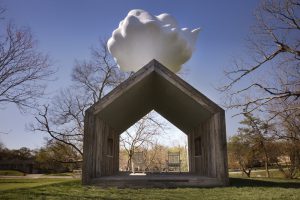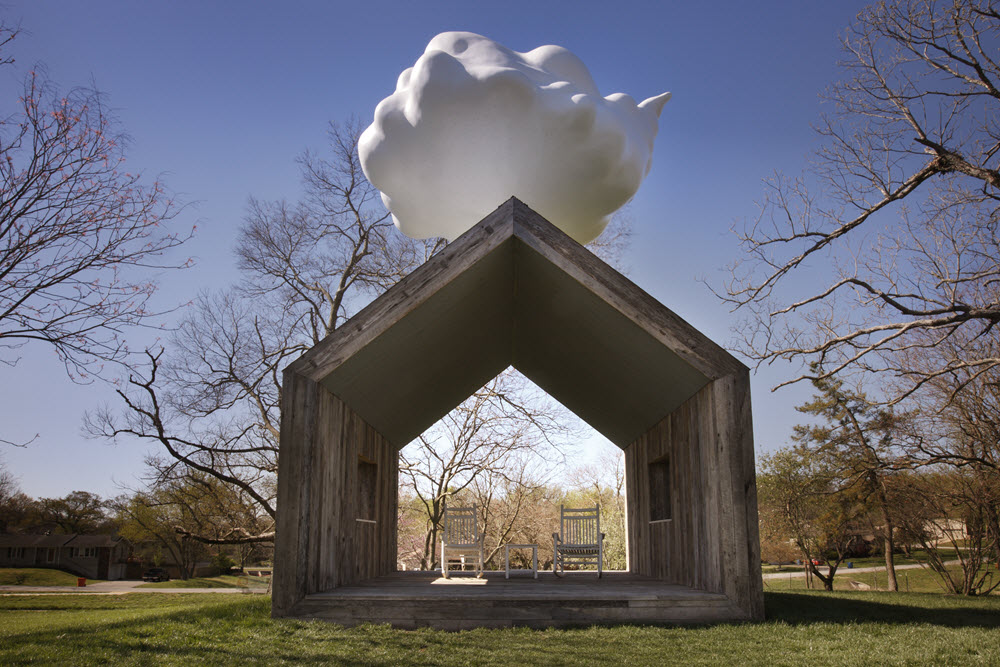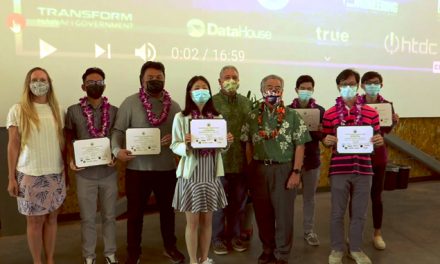On even the clearest day at Farmer’s Park in Springfield, Mo., visitors can spot at least one cloud in the sky. Like most clouds, it carries moisture, and drops rain under the right conditions. But unlike most clouds, this one is made from acrylic resin and sits tethered to the tin roof of a small barn.
This artistic puff is a central part of Cloud House, an interactive art exhibit constructed by conceptual artist Matthew Mazzotta. Installed next to the largest farmer’s market in Springfield, the piece draws attention to the interconnectedness of food production and the water cycle.
“I really like this quote from the Farm Equipment [Manufacturer’s] Association,” says Mazzotta, in a video introducing his work. “Despite all our accomplishments, we owe our existence to a 6-in. layer of topsoil and the fact that it rains.”
Audience participation
From the outside, viewers see a shed-sized wooden barn, fully open on both ends, with a bright white cloud supported by a pipe looming just overhead. In the windowsill beneath two square openings on either side of the barn are edible plants. Through the open doorway sit two white rocking chairs, inviting passersby to rest.

Cloud House, a public art installation by conceptual artist Matthew Mazzotta, is a self-contained demonstration of the water cycle. Mazzotta and his partners built Cloud House out of wood and tin from a nearby abandoned farm. It is now located in the Farmer’s Park neighborhood of Springfield, Mo., where it prompts viewers to consider their dependence on the water cycle. (Tim Hawley)
What viewers won’t see are a hidden system of gutters that line the gabled rooftop, pipes within the barn walls that carry stormwater throughout the installation during rainstorms, or an underground cistern that holds collected rain. They also won’t see the pressure sensors in the floor beneath the rocking chairs.
Sitting on either chair triggers a pump that brings stormwater from the cistern back up toward the cloud and through several tiny holes to simulate rainfall. For a second time, stormwater falls from the roof into the gutters, which provide water to the plants in the windowsills before returning to the underground storage tank.
During dry parts of the year, when not enough rain has fallen to fill the cistern, sitting in the rocking chairs does nothing. If dry conditions persist for long enough, eventually the windowsill plants wilt. The artist says the effect illustrates our dependence on nature to remain healthy.
“It is becoming increasingly important that we have a clear understanding of how closely we are tied to ecological systems like the water cycle,” Mazzotta said. “Cloud House offers a moment to sit in a rocking chair and listen to the rain on the tin roof to reflect on the fragile dance we are in with nature and our own survival.”
Art with a purpose
Mazzotta developed the idea for Cloud House during a 2-month artist-in-residence program at Farmer’s Park. The artist, who graduated from the Massachusetts Institute of Technology (Cambridge) with a master’s degree in visual studies, has created over a dozen large-scale public art projects focused on viewer participation and advocacy for environmental issues.
Among Mazzotta’s other works are Harm to Table, a large, wooden dining set based in Boulder, Colo., that serves guests a free dinner made from local plants threatened by climate change, and Busycle, a 15-person vehicle that ambles through Nebraska’s open roads using only the power provided by riders’ legs.
Cloud House will remain at the market at Springfield’s Farmer’s Park indefinitely, reminding customers of the essential role that water plays in food production.






